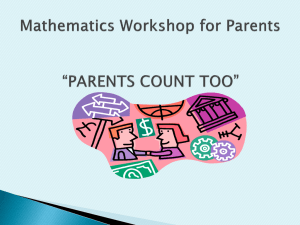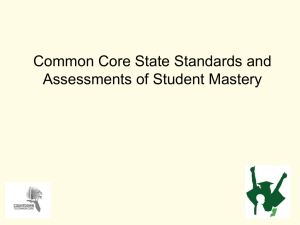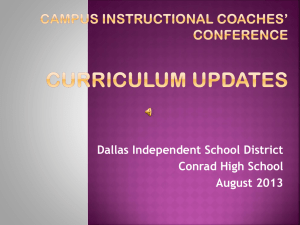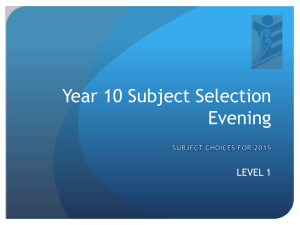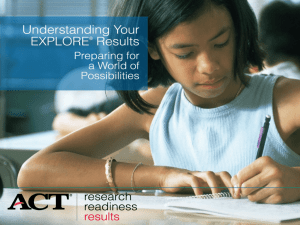Understanding the Common Core State Standards
advertisement
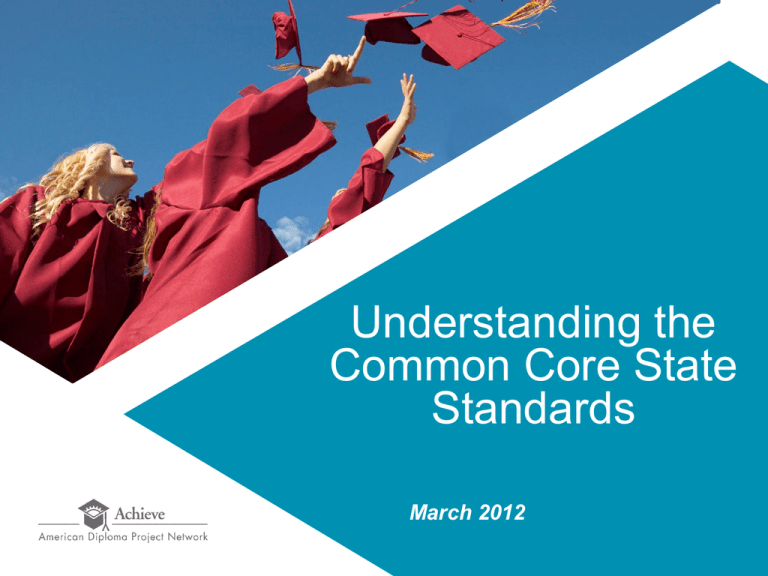
Understanding the Common Core State Standards March 2012 Why Common Core State Standards? We need them because Disparate standards across the states Global, not neighborhood competition For many young people, high school wasn’t preparing them for college or careers Why the CCSS Are Important Prepare students with knowledge and skills to succeed in college and career Ensure consistent expectations regardless of a student’s zip code Provide educators, parents and students with clear, focused guideposts Offer economies of scale and sharing of best practices 2 Why Common Core State Standards? Preparation: The standards are college- and career-ready. They will help prepare students with the knowledge and skills they need to succeed in education and training after high school. Competition: The standards are internationally benchmarked. Common standards will help ensure our students are globally competitive. Equity: Expectations are consistent for all – and not dependent on a student’s zip code. Clarity: The standards are focused, coherent, and clear. Clearer standards help students (and parents and teachers) understand what is expected of them. Collaboration: The standards create a foundation to work collaboratively across states and districts, pooling resources and expertise, to create curricular tools, professional development, common assessments and other materials. 3 The Common Core State Standards Initiative Beginning in the spring of 2009, Governors and state commissioners of education from 48 states, 2 territories and the District of Columbia committed to developing a common core of state K-12 English-language arts (ELA) and mathematics standards. The Common Core State Standards Initiative (CCSSI) was a state-led effort coordinated by the National Governors Association (NGA) and the Council of Chief State School Officers (CCSSO). www.corestandards.org 4 Common Core State Standards Design Building on the strength of current state standards, the CCSS are designed to be: Focused, coherent, clear and rigorous Internationally benchmarked Anchored in college and career readiness* Evidence- and research-based *Ready for first-year credit-bearing, postsecondary coursework in mathematics and English without the need for remediation. 5 Process K-12 Common Standards: Core writing teams in English Language Arts and Mathematics (See www.corestandards.org for list of team members) External and state feedback teams provided on-going feedback to writing teams throughout the process Draft K-12 standards were released for public comment on March 10, 2010; 9,600 comments received Validation Committee of leading experts reviews standards Final standards were released June 2, 2010 6 Common Core State Standards Evidence Base Evidence was used to guide critical decisions in the following areas: Inclusion of particular content Timing of when content should be introduced and the progression of that content Ensuring focus and coherence Organizing and formatting the standards Determining emphasis on particular topics in standards Evidence includes: Standards from high-performing countries, leading states, and nationallyregarded frameworks Research on adolescent literacy, text complexity, mathematics instruction, quantitative literacy Lists of works consulted and research base included in standards’ appendices 7 Common Core State Standards Evidence Base For example: Standards from individual high-performing countries and provinces were used to inform content, structure, and language. Writing teams looked for examples of rigor, coherence, and progression. Mathematics 1. 2. 3. 4. 5. 6. 7. 8. 9. 10. 11. 12. Belgium (Flemish) Canada (Alberta) China Chinese Taipei England Finland Hong Kong India Ireland Japan Korea Singapore English language arts 1. 2. 3. 4. 5. 6. 7. Australia • New South Wales • Victoria Canada • Alberta • British Columbia • Ontario England Finland Hong Kong Ireland Singapore 8 Feedback and Review External and State Feedback teams included: K-12 teachers Postsecondary faculty State curriculum and assessments experts Researchers National organizations (including, but not limited, to): American Council on Education (ACE) National Council of Teachers of English (NCTE) American Federation of Teachers (AFT) Campaign for High School Equity (CHSE) National Council of Teachers of Mathematics (NCTM) Conference Board of the Mathematical Sciences (CBMS) National Education Association (NEA) Modern Language Association (MLA) 9 46 States + DC Have Adopted the Common Core State Standards * Minnesota adopted the CCSS in ELA only 10 Common Core State Standards for Mathematics Key Instructional Shifts in Mathematics The Common Core State Standards emphasize coherence at each grade level – making connections across content and between content and mathematical practices in order to promote deeper learning. The standards focus on key topics at each grade level to allow educators and students to go deeper into the content. The standards also emphasize progressions across grades, with the end of progression calling for fluency – or the ability to perform calculations or solving problems quickly and accurate. The Standards for Mathematical Practice describe mathematical “habits of mind” or mathematical applications and aim to foster reasoning, problem solving, modeling, decision making, and engagement among students. Finally, the standards require students to demonstrate deep conceptual understanding by applying them to new situations. Source: 12 Organization of Common Core State Standards for Mathematics Grade-Level Standards K-8 grade-by-grade standards organized by domain 9-12 high school standards organized by conceptual categories Standards for Mathematical Practice Describe mathematical “habits of mind” Connect with content standards in each grade 13 Standards for Mathematical Practice Eight Standards for Mathematical Practice Make sense of problems and persevere in solving them Reason abstractly and quantitatively Construct viable arguments and critique the understanding of others Model with mathematics Use appropriate tools strategically Attend to precision Look for and make use of structure Look for and express regularity in repeated reasoning 14 Overview of K-8 Mathematics Standards The K- 8 standards: The K-5 standards provide students with a solid foundation in whole numbers, addition, subtraction, multiplication, division, fractions and decimals The 6-8 standards describe robust learning in geometry, algebra, and probability and statistics Modeled after the focus of standards from high-performing nations, the standards for grades 7 and 8 include significant algebra and geometry content Students who have completed 7th grade and mastered the content and skills will be prepared for algebra, in 8th grade or after 15 Overview of K-8 Mathematics Standards Each grade includes an overview of crosscutting themes and critical areas of study 16 Format of K-8 Mathematics Standards Domains: overarching ideas that connect topics across the grades Clusters: illustrate progression of increasing complexity from grade to grade Standards: define what students should know and be able to do at each grade level 17 Overview of High School Mathematics Standards The high school mathematics standards: Call on students to practice applying mathematical ways of thinking to real world issues and challenges Require students to develop a depth of understanding and ability to apply mathematics to novel situations, as college students and employees regularly are called to do Emphasize mathematical modeling, the use of mathematics and statistics to analyze empirical situations, understand them better, and improve decisions Identify the mathematics that all students should study in order to be college and career ready 18 Format of High School Mathematics Standards Content/Conceptual categories: overarching ideas that describe strands of content in high school Domains/Clusters: groups of standards that describe coherent aspects of the content category Standards: define what students should know and be able to do at each grade level High school standards are organized around five conceptual categories: Number and Quantity, Algebra, Functions, Geometry, and Statistics and Probability Modeling standards are distributed under the five major headings and are indicated with a () symbol Standards indicated as (+) are beyond the college and career readiness level but are necessary for advanced mathematics courses, such as calculus, discrete mathematics, and advanced statistics. Standards with a (+) may still be found in courses expected for all students 19 Format of High School Mathematics Standards Each content category includes an overview of the content found within it 20 Model Course Pathways for Mathematics Model Mathematics Pathways: Developed by a panel of experts convened by Achieve, including many of the standards writers and reviewers Organize the content of the standards into coherent and rigorous courses Illustrate possible approaches—models, not mandates or prescriptions for organization, curriculum or pedagogy Require completion of the Common Core in three years, allowing for specialization in the fourth year Prepare students for a menu of courses in higher-level mathematics 21 Model Course Pathways for Mathematics Courses in higher level mathematics: Precalculus, Calculus (upon completion of Precalculus), Advanced Statistics, Discrete Mathematics, Advanced Quantitative Reasoning, or other courses to be designed at a later date, such as additional career technical courses. Algebra II Mathematics III Geometry Mathematics II Algebra I Mathematics I Pathway A Pathway B Traditional in U.S. International Integrated approach (typical outside of U.S.) . 22 Common Core State Standards for English Language Arts and Literacy in History/ Social Studies, Science, and Technical Subjects Key Instructional Shifts in ELA/Literacy In Reading, the major advances are the shift away from literature-focused standards to a balance of literature and informational texts to reflect college- and career-ready expectations. There is also a greater focus on text complexity and at what level students should be reading. In Writing, there is a strong emphasis on argument and informative/ explanatory writing, along with an emphasis on writing about sources or using evidence to inform an argument. The Common Core also include Speaking and Listening expectations, including a focus on formal and informal talk, which can be done through presentations and group work. The Language standards put a stress on both general academic and domain-specific vocabulary. The Common Core also address reading, writing and literacy across the curriculum, and include literacy standards for science, social studies and technical subjects. These standards complement rather than replace content standards in those subjects, and are the responsibility of teachers in those specific disciplines, making literacy a shared responsibility across educators. Source: 24 Common Core State Standards for English Language Arts and Literacy in History/Social Studies, Science, and Technical Subjects College and Career Readiness (CCR) Standards Overarching standards for each strand that are further defined by gradespecific standards Grade-Level Standards in English Language Arts K-8, grade-by-grade 9-10 and 11-12 grade bands for high school Four strands: Reading, Writing, Speaking and Listening, and Language Standards for Literacy in History/Social Studies, Science, and Technical Subjects Standards are embedded at grades K-5 Content-specific literacy standards are provided for grades 6-8, 9-10, and 11-12 25 Overview of Reading Strand Reading Progressive development of reading comprehension; students gain more from what they read Emphasize the importance of grade-level texts that are of appropriate difficulty and are increasingly sophisticated Standards for Reading Foundational Skills (K-5) Reading Standards for Literature (K-12) Reading Standards for Informational Text (K-12) Reading Standards for Literacy in History/Social Studies (6-12) Reading Standards for Literacy in Science and Technical Subjects (612) 26 Overview of Text Complexity Reading Standards include over exemplar texts (stories and literature, poetry, and informational texts) that illustrate appropriate level of complexity by grade Text complexity is defined by: 1. Qualitative measures – levels of meaning, structure, language conventionality and clarity, and knowledge demands 2. Quantitative measures – readability and other scores of text complexity 3. Reader and Task – background knowledge of reader, motivation, interests, and complexity generated by tasks assigned Reader and Task 27 Example of Grade-Level Progression in Reading CCR Reading Standard 3: Analyze how and why individuals, events, and ideas develop and interact over the course of a text. Reading Standards for Literature Reading Standards for Informational Text Grade 3: Describe characters in a story (e.g., their traits, motivations, or feelings) and explain how their actions contribute to the sequence of events. Grade 3: Describe the relationships between a series of historical events, scientific ideas of concepts, or steps in technical procedures in a text, using language that pertains to time, sequence, and cause/effect. Grade 7: Analyze how particular elements of a story or drama interact (e.g., how setting shapes the characters or plot) Grade 7: Analyze the interactions between individuals, events, and ideas in a text (e.g., how ideas influence individuals or events, or how individuals influence ideas or events). Grades 11-12: Analyze the impact of the author’s choices regarding how to develop and relate elements of a story or drama (e.g., where a story is set, how the action is ordered, how the characters are introduced and developed). Grades 11-12: Analyze a complex set of ideas or sequence of events and explain how specific individuals, ideas, or events interact and develop over the course of the text. 28 Grade-Level Progression Format highlights progression of standards across grades 29 Overview of Writing Strand Writing Expect students to compose arguments and opinions, informative/explanatory pieces, and narrative texts Focus on the use of reason and evidence to substantiate an argument or claim Emphasize ability to conduct research – short projects and sustained inquiry Require students to incorporate technology as they create, refine, and collaborate on writing Include student writing samples that illustrate the criteria required to meet the standards (See standards’ appendices for writing samples) 30 Overview of Speaking and Listening and Language Strands Speaking and Listening Focus on speaking and listening in a range of settings, both formal and informal – academic, small-group, whole-class discussions Emphasize effective communication practices Require interpretation and analysis of message as presented through oral, visual, or multimodal formats Language Include conventions for writing and speaking Highlight the importance of vocabulary acquisition through a mix of conversation, direct instruction, and reading To be addressed in context of reading, writing, speaking and listening Media and Technology are integrated throughout the CCSS 31 Overview of Standards for History/Social Studies, Science, and Technical Subjects Reading Standards for History/Social Studies, Science, and Technical Subjects Knowledge of domain-specific vocabulary Analyze, evaluate, and differentiate primary and secondary sources Synthesize quantitative and technical information, including facts presented in maps, timelines, flowcharts, or diagrams Writing Standards for History/Social Studies, Science, and Technical Subjects Write arguments on discipline-specific content and informative/explanatory texts Use of data, evidence, and reason to support arguments and claims Use of domain-specific vocabulary 32 Understanding the Common Core State Standards March 2012

